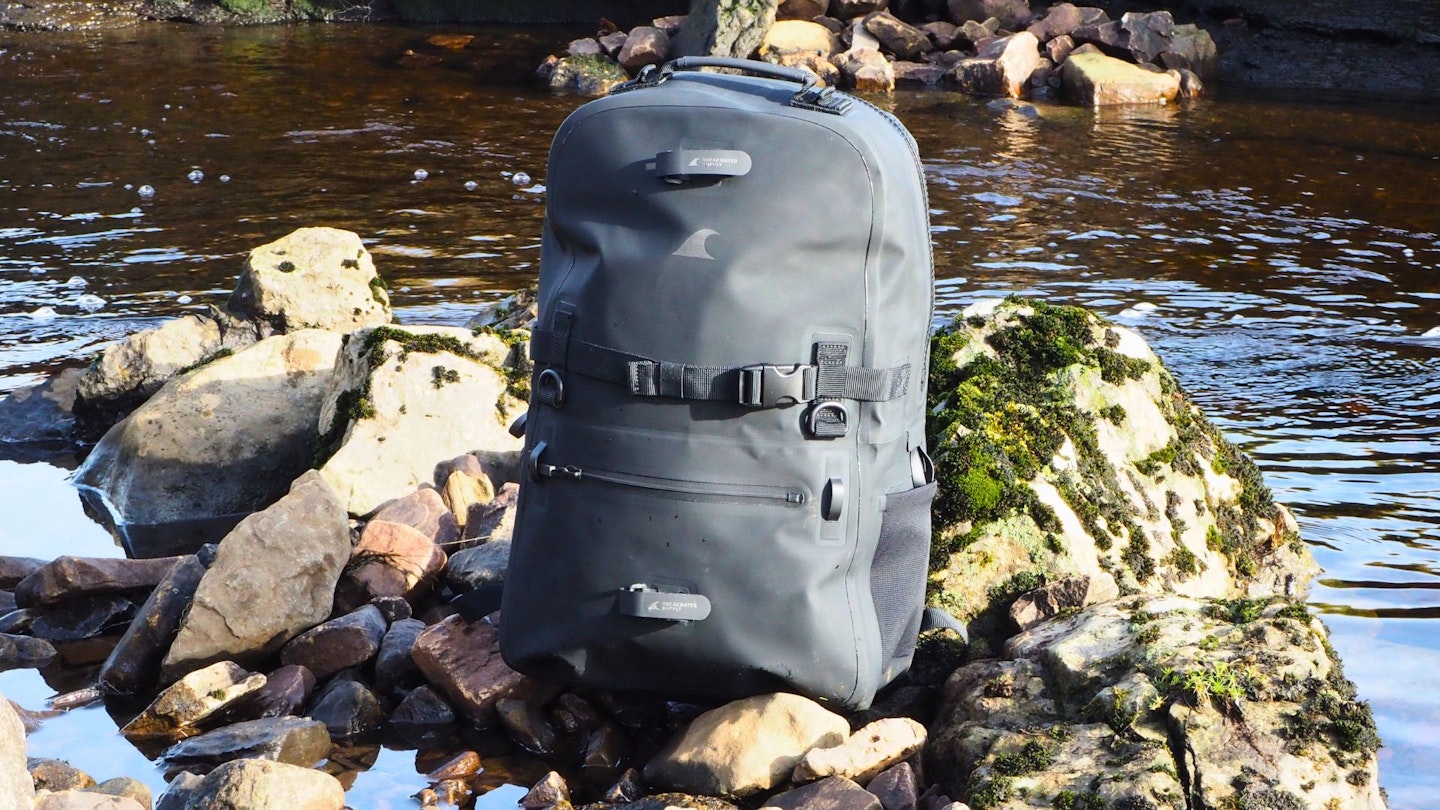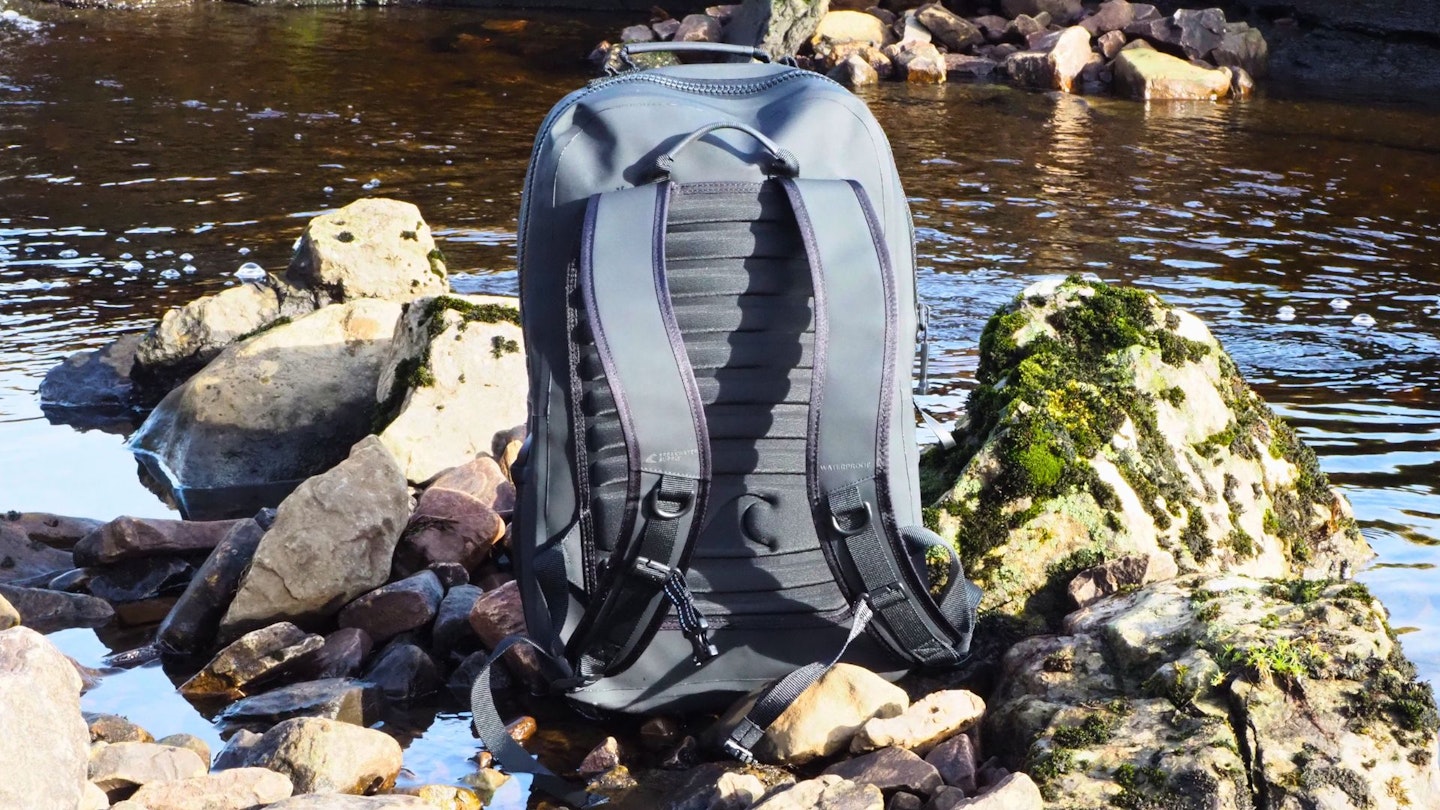For a very long time backpacks were not waterproof. Certainly not those designed for everyday use, and those meant for hiking came with a raincover instead. But there has been a recent proliferation of waterproof backpacks – this model, the Fogland from Breakwater Supply, being just one of many.
If you’re wondering why hiking and trekking backpacks have never been waterproof, it’s because the highly water resistant or impermeable fabrics needed for waterproofing don’t have the desirable traits you want for a hiking pack, i.e., lightness, breathability, and abrasion resistance.
But that hasn’t stopped this deluge washing up a legion of waterproof backpacks with their dry interiors. They seem to come in two types: a glorified dry bag with shoulder straps, or stiff and boxy, designed to be completely watertight.
The Fogland sits in the latter camp. It looks more or less like a regular daypack, but with its IP68 rating and TPU body it’s designed to be 100% watertight and submersible. Interested in whether Breakwater Supply has managed to also make the Fogland a comfortable, practical backpack, we’ve been trying it out.

Pros
- Truly waterproof and submersible
- Useful as a general daypack
- Tough
- Extra pockets and gear attachment points
- Range of volumes and colours
Cons
- Water bottle pockets only accommodate small bottles
- Not a technical hiking pack
| Weight | 1.1kg |
| Volumes | 15L, 20L, 25L |
| Materials | TPU-coated 420D nylon |
Design and features

Let’s start with what makes the Fogland waterproof. The body is made from 420D nylon coated on both sides with TPU. Breakwater Supply aptly calls this fabric Hydrowall because it’s totally impregnable for water, dust, and dirt.
The main and front pocket zips are watertight and to ensure seams don’t fail, Breakwater Supply doesn’t use stitching or taped seams on the TPU body, but radio frequency welded seams. We’ve seen this approach before on Sea To Summit gear. RF welding doesn't do much for flexibility but a huge amount for permanently sealed, durable seams.

External features include small drinks pockets on each side, attachment points (in the form of D-rings and a strap), and a zipped front pocket. The EVA back panel is grooved like wave ripples in the sand, and the shoulder straps have neoprene padding.
Inside, in addition to the main compartment, you’ll find a laptop sleeve and a zipped pocket for valuables.
Performance and comfort

Breakwater Supply says the Fogland is ready for anything. As far as versatility goes, we were quite impressed with the Fogland, largely because of its comfort and useful features.
The back panel and straps do a fine job for being comfortable all day long, with two provisos: first, the bag isn’t loaded too heavy (this weight threshold varies between people) because there is no hip belt and the straps aren’t super supportive. Second, you’re not doing a challenging hike or mountain trek because the back panel isn’t especially breathable.
But if you’re going for a leisurely walk, heading to the beach, or commuting (rain or shine), for example, the Fogland is quite an impressive backpack.

There are aspects of the Fogland that you need to be aware of. The main zip, for example, is stiff and you need to make sure it’s fully closed otherwise the watertightness is compromised. You also need to lubricate it every so often (this comes with the bag). The drink bottle sleeves are also quite small and won’t take a bottle with a diameter of more than 8cm.
We like the Fogland’s overall tough construction, though. Unlike many lightweight waterproof bags, the Fogland is resistant to punctures and abrasion. It really is completely waterproof too – chuck it in a lake, and you won’t have soggy snacks. Because the bag is airtight when zipped up, the Fogland is also buoyant.
Sustainability

There isn’t a huge amount to disclose here, although the durability and longevity of the Fogland are to the benefit of sustainability.
Breakwater Supply also says its Hydrowall fabric is recyclable and non-toxic, and that it doesn’t use ‘materials and finishes that can damage the ecosystem’.
Price and competition
Breakwater Supply sells online via its US site and the Fogland can be bought in the UK through Amazon. As such, prices can fluctuate a bit and so too can availability.
We tested the 25L version but the 20L seems to be the most reliably stocked and costs around £200-£210. That’s no bargain but is about a third less than the Fogland’s closest rival – the Yeti Panga 28L Backpack.
Verdict

We think the Breakwater Supply Fogland is pretty limited in its abilities as a true hiking backpack, but that’s it’s only major weakness.
As an everyday, water sport, and adventure backpack it’s rather impressive. Sure the zipper is stiff but for absolute waterproofness, that’s an easy trade-off. The Fogland is also surprisingly comfortable and very well made.
You may just have to wait for the volume and colour you want in the UK, since availability can be patchy.
How we tested

Chris Williams, one of our staff writers and gear testers, was charged with putting the Breakwater Supply Fogland to work over the course of a couple of months.
Chris has been working on LFTO since 2021 and has several years of journalistic and outdoor industry experience, in addition to being an avid hiker all his life.
